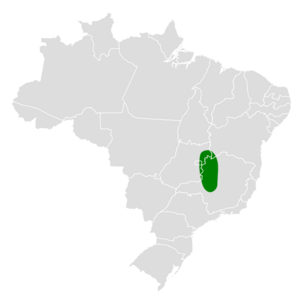Brasília tapaculo facts for kids
Quick facts for kids Brasília tapaculo |
|
|---|---|
 |
|
| Conservation status | |
| Scientific classification | |
| Genus: |
Scytalopus
|
| Species: |
novacapitalis
|
 |
|
The Brasília tapaculo (Scytalopus novacapitalis) is a small, shy bird. It is found only in a specific part of Brazil. This special bird is known for hiding in dense plants. It also has unique calls. The Brasília tapaculo is part of the Rhinocryptidae family. These birds are sometimes called "scythe-bills" because of their strong beaks.
Contents
Meet the Brasília Tapaculo
The Brasília tapaculo was first discovered in 1958. It was named by a scientist named Helmut Sick. This bird is closely related to other tapaculo species. These include the Planalto tapaculo and the rock tapaculo. They all belong to a group of similar birds.
What Does the Brasília Tapaculo Look Like?
The Brasília tapaculo is about 11 cm (4.3 in) long. That's about the length of a small pencil. An adult male bird weighs around 19.2 g (0.68 oz). This is about the same as a few quarters.
Its feathers are blue-gray on its back and head. Its belly is whitish or light gray. The lower part of its back and its rump (the area above its tail) are reddish-brown. The feathers under its tail are also reddish-brown with gray stripes. Young Brasília tapaculos have not been fully described yet.
Where Does the Brasília Tapaculo Live?
The Brasília tapaculo lives in eastern Goiás, the Distrito Federal, and western Minas Gerais. These areas are all in southern Brazil. It lives in special places called gallery forests. These are forests that grow along rivers or streams.
The bird especially likes areas that are always wet. It often hides among Blechnum ferns and Euterpe palm trees. It prefers to live at elevations between 800 to 1,000 m (2,600 to 3,300 ft) high.
How Does the Brasília Tapaculo Behave?
What the Brasília Tapaculo Eats
The Brasília tapaculo finds its food on the ground. It looks for small creatures like insects, spiders, and centipedes. It uses its strong beak to search for these tasty snacks.
Breeding Habits
Scientists do not know much about how the Brasília tapaculo raises its young. The only information found is from a bird collected in July. This bird showed signs of being ready to breed. More research is needed to learn about their nests and baby birds.
The Sounds It Makes
The Brasília tapaculo has a unique song. It makes an "ewk" sound that it repeats for up to a minute. You can hear an example of its song online [1].
It also has an alarm call. This call is a series of sharp "che-te-te" notes. When it wants to make another type of call, it uses a fast series of "chip" notes. These "chip" notes get louder as the bird sings them.
Is the Brasília Tapaculo in Danger?
The IUCN (International Union for Conservation of Nature) says the Brasília tapaculo is an Endangered species. This means it is at a high risk of becoming extinct. Its home area is quite small, about 72 square kilometers (28 square miles). This area is also broken up into many small pieces.
The places where it lives are still being destroyed. This is a big problem for the bird. However, there is some good news. The Brasília tapaculo lives in at least six protected areas. These areas help keep its habitat safe from harm. Protecting these places is important for the survival of this unique Brazilian bird.


